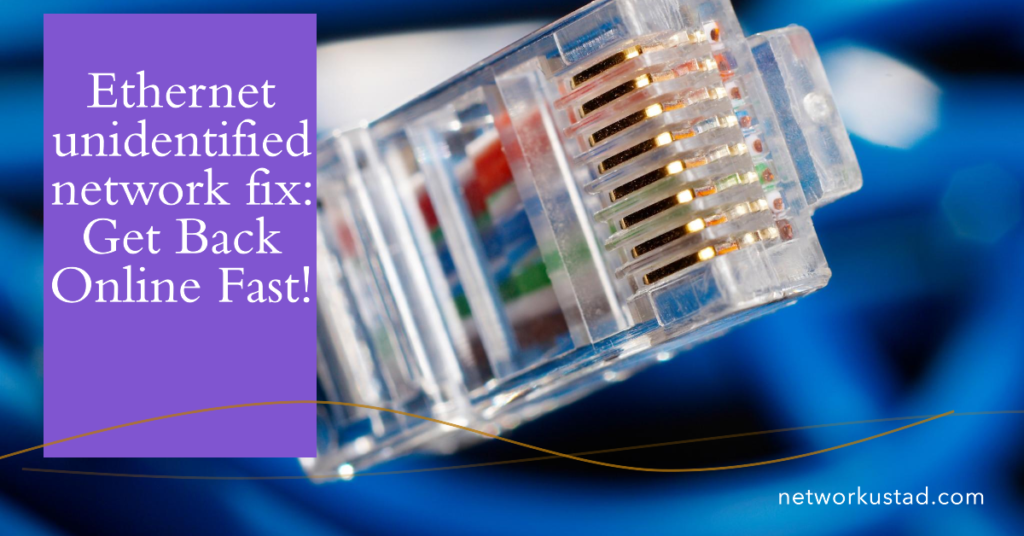Seeing an ‘Unidentified Network‘ message with your Ethernet cable is frustrating. It would help if you had a reliable internet connection. This usually means your computer can’t find the network, and you can’t access the internet as a result. Troubleshooting steps are available to resolve the issue. They provide a swift solution.
Understanding the ‘Unidentified Network’ Error
Before we can provide solutions, we must determine the cause of the “Unidentified Network” error. Hardware issues: Network errors can be caused by bad Ethernet cables, damaged ports, or failing network cards.
- Driver issues: Old or corrupt network drivers may block your connection.
- Incorrect settings: Misconfigured network settings or IP addresses can cause issues.
- Software conflicts: Third-party apps, especially security software, can mess up the network.
Step-by-Step Solutions to Fix the Error

1. Check Your Hardware
First, check your Ethernet cable, ports, and network card. Then, inspect the cable connection for damage. For example, fraying or cuts in the cable may cause the issue. Replacing it with a new one may fix it. Also, try a different port on your router or switch to rule out hardware issues.
2. Restart Your Network Devices
Modem and router restarts resolve network errors. Unplug these devices, wait 30 seconds, and then plug them back in. It can refresh the connection and fix glitches.
3. Disable Airplane Mode
Make sure you turn off Airplane mode on your computer. This mode, when on, can disable all network connections, even wired ones. Make sure the Airplane mode is off.
4. Update Network Drivers
Outdated network drivers can cause connectivity issues. To update your drivers:
- Right-click the Start button and select “Device Manager” to open it.
- Expand the “Network Adapters” section.
- Right-click on your Ethernet adapter. Then, select “Update driver.
- Have Windows find the best driver for you.
If updating doesn’t fix it, reinstall the drivers. You can also uninstall the network adapter. Right-click on it and choose ‘Uninstall device.’ Restart your computer. Windows will reinstall it.
5. Check Network Settings
Verify that your network settings are correct. Set your computer to auto-obtain an IP and DNS unless a static IP is needed. You can check this by going to:
- Control Panel. Then, Network and Sharing Center. Next, Change Adapter Settings.
- Find your network and click on it with the right mouse button.
- Select “Internet Protocol Version 4 (TCP/IPv4)” and click “Properties.
- Choose the automatic IP address assignment option. Also, select “Get DNS server address automatically.” 6. Switch off security programs for a brief period.
Security software can sometimes block network connections. Security software can sometimes block network connections. Disable your security software to diagnose the issue. Remember to turn it back on afterward. Then, Update & Security. Next, Windows Security. Finally, Firewall & Network Protection.
7. Use Windows Network Troubleshooter
Windows has a network troubleshooter. It can find and fix common network problems.
- Try using the built-in network troubleshooter. Follow the steps it provided to fix the problem.
8. Reset Network Components
If the above steps don’t work, you can reset your network components using Command Prompt:
- Search for ‘Command Prompt’ and right-click on the result to open it with administrator rights.
- Type some given commands below and press Enter after each one.
netsh winsock reset
netsh int ip reset
ipconfig /release
ipconfig /renew
ipconfig /flushdns
- Restart your computer after executing these commands.
9. Set a Static IP Address
If you suspect DHCP issues, try a static IP. It should be in your network’s correct range. For example, if your router uses the address 192.168.1.1, you can set your computer’s address to 192.168.1.100. You’ll also need to use the subnet mask 255.255.255.0.

FAQs:
What does “Unidentified Network” mean?
- An “Unidentified Network” message means your PC is not online. This is usually due to wrong settings, old software, or hardware issues.
How can I know if my Ethernet cable is faulty?
- Try using a different Ethernet cable to check if the cable is the problem. You can also test the cable by plugging it into another device. If it works there, the cable is likely fine. Also, look for any damage to the cable, like broken wires.
Can I fix the “Unidentified Network” issue without a technician?
- Yes, you can fix many “Unidentified Network” issues. Follow the steps in this article. “Try the simple fixes first. “If the problem persists, ask for help,” Technician.
Conclusion:
Getting an ‘Unidentified Network’ error is frustrating, but don’t worry—you can often fix it yourself. First, check your cables. Then, make sure your computer and router are on. Update your network software. Then, try the troubleshooting tools. If these steps don’t work, you might need to adjust your network settings. Consider resetting the network components. Follow these steps to restore your online connection now. If you’ve tried everything and the problem still exists, seek help.




